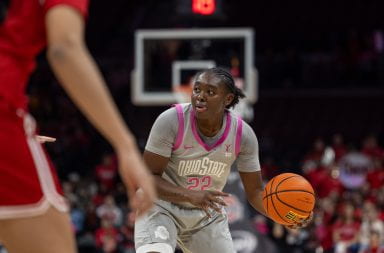
A conceptual rendering depicting part of the approved expansion and enhancement to the OSU Veterinary Medical Center (VMC). Credit: Courtesy of OSU
The intensive care unit at the Ohio State Veterinary Medical Center is undergoing renovations, adding a command center that will allow for monitoring and care of patients, two isolation wards and a visitation center, among other new extensions.
The newly renovated ICU would also allow the Veterinary Medical Center to start new treatment options for ill pets, such as dialysis, said Dr. Rustin Moore, associate executive dean of the College of Veterinary Medicine.
Dialysis, set to be added this spring, will be used to help animals with kidney disease or toxicities, Moore said.
“With clients before that, we didn’t have that capacity,” he said.
Construction on the OSU Veterinary Medical Center began in mid-August, with a groundbreaking ceremony on Sept. 5. It is estimated to last until fall 2015 and will cost $750,000 as part of the $16.8 million Phase One of a renovation project of the Veterinary Medical Center, Moore said.
The nearly $30 million renovation and expansion of the center is set to be completed in three years. The renovations to the ICU are part of the project’s multi-phase plan.
The renovations are aimed to update the ICU and help to better serve the patients who need treatment there, Moore said.
“It’s really about (the fact that) we’ve outgrown the capacity of our current facility and so we needed to find an area to expand in,” he said. “There will be three times the amount of space in the ICU as well as the other additions, which we think will give us capacity both for what we need now but also the future.”
One of the benefits of the ICU renovations will be that more space will be available for students and doctors to do their treatments, said Dr. Edward Cooper, an emergency and critical care veterinarian at the Veterinary Medical Center.
“The current ICU is too small and congested and so it limits accessibility to some of their patients,” he said.
Cooper added that the new design will also allow pet owners to visit patients while still being near the ICU.
“We’ll be able to bring their pet into (the added) visiting room so they can spend time (with their pets), still close to the ICU for some of our sicker patients, but rather than having to visit in the ICU itself or bring the pet all the way up to one of our current visiting rooms, we’ll have it all in one location,” Cooper said.
Moore added that the new layout will also better accommodate the ill pets who come to the center for treatment.
“Because the ICU is for the critically ill dogs and cats are hospitalized, many times they can’t go up to the front of the building to an exam room to visit,” he said.
Two of the biggest expectations of the renovations are that there will be more room for patients and the space will look nicer for clients, Cooper said.
“Even from the standpoint of when we do have clients that come back to the ICU visiting their pets, just even the visual impact of the current ICU doesn’t speak to the level of care that we can provide, the level of expertise that we offer, and the technology that we use,” he said. “You just sort of see … what looks like an old holding ward that was transitioned into being an ICU.”


